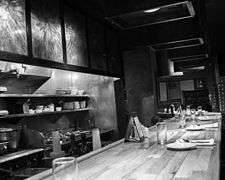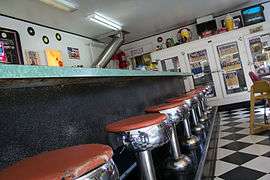Lunch counter


A lunch counter (also known as a luncheonette) is a small restaurant, much like a diner, where the patron sits on a stool on one side of the counter and the server or person preparing the food serves from the other side of the counter, where the kitchen or limited food preparation area is. As the name suggests, they were most widely used for the lunch time meal. Lunch counters at one time were commonly located inside of retail variety stores (or "five and dimes" as they were called in the United States) and smaller department stores. The intent of the lunch counter in a store was to both profit from taking care of hungry shoppers and attract people to the store more often in the hopes that they might buy some merchandise or cross two errands off their list in one location.
History
Woolworth's, an early five and dime chain of stores, opened their first luncheonette in New Albany, Indiana, and expanded rapidly from there.[1] Lunch counters were often found in other dimestores, like Newberry's, S. H. Kress, H.L. Green, W.T. Grant, McLellan's or McCrory's. Members of the retail staff who had taken lunch counter training would staff the counter during lunch time, or if a shopper wanted to place an order for a snack. Typical foods served were hot and cold sandwiches (e.g., ham and cheese, grilled cheese, BLT, patty melt, egg salad), soups, pie, ice cream (including sundaes, ice cream sodas and milkshakes), soda, coffee and hot chocolate.
Significance in the American Civil Rights movement
Integrating lunch counters in the Southern United States through the use of sit-in political protests in the 1960s was a major accomplishment of the Civil Rights Movement. These involved Black Americans and their supporters sitting at the lunch counter in areas designated for "whites only", insisting that they be allowed to purchase and be served food or beverages.
Gallery
 John's Cafe in Portland, Oregon
John's Cafe in Portland, Oregon Randy's Restaurant counter in Seattle, Washington
Randy's Restaurant counter in Seattle, Washington 13 Coins counter in Seattle, Washington
13 Coins counter in Seattle, Washington.jpg) A lunch counter in Low Pass, Oregon
A lunch counter in Low Pass, Oregon A lunch counter in a very small restaurant
A lunch counter in a very small restaurant A man eating lunch at a lunch counter
A man eating lunch at a lunch counter A 1950s lunch counter
A 1950s lunch counter A dirty lunch counter
A dirty lunch counter A lunch counter serving the elderly
A lunch counter serving the elderly The lunch counter in Jarbidge
The lunch counter in Jarbidge The lunch counter at the JAX Truckee Diner
The lunch counter at the JAX Truckee Diner
See also
References
- ↑ Barksdale, David C. & Sekula, Robyn Davis (2005). New Albany in Vintage Postcards, p. 2; ISBN 978-0-7385-3386-5
Further reading
- "Sitting for Equal Service: Lunch Counter Sit-ins, United States, 1960s - Melody Herr". Retrieved 2013-08-05.
- "Food: A Dictionary of Literal and Nonliteral Terms - Robert Allen Palmatier". Retrieved 2013-08-05.
External links
| Wikimedia Commons has media related to Lunch counters. |